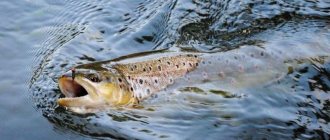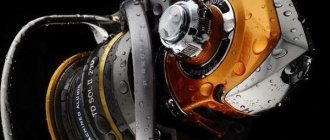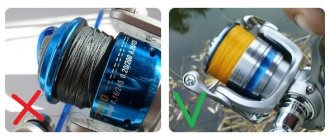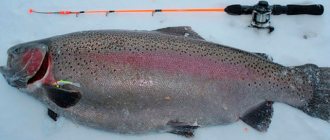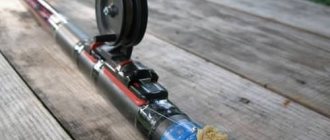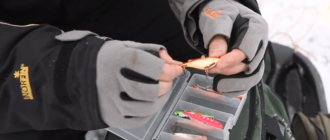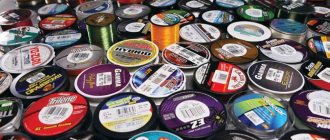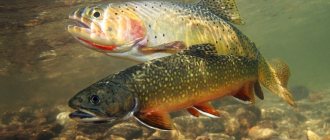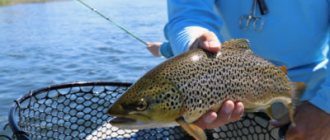Best winter fishing season
In many paid reservoirs, trout is the only fish that is caught in winter. It is necessary to understand that trout practically does not grow in fishing ponds, but is brought in tanks from special fisheries, where it is grown to marketable weight on artificial feed. Trout is a cold-loving fish and is caught from the freeze-up period (late November - early December) until spring (late March). The trout bite often does not weaken even in the middle of winter, in the most frosty or inclement weather, in the so-called dead winter, while other fish are caught very poorly.
Best time to catch trout
Like many other fish, the winter trout bite begins early in the morning, at dawn, and continues until lunch (11–12 o’clock). This is followed by a short break, and towards the evening (15–16 hours), there is often an “evening outing” of fish, not as long as the morning one (up to one hour), but often just as active.
It’s better to arrive at the reservoir while it’s still dark, and with gear prepared in advance at home, so that by sunrise you’ll be ready to start fishing. If you didn’t manage to catch a fish in the morning, you should wait for the evening bite and leave as soon as it gets dark.
At night fishing on paid reservoirs is usually prohibited, but where it is allowed, there are small bursts of fish activity at night.
Active winter tackle for trout fishing
Tackle for winter trout fishing is divided into two categories. The so-called “asset” and “liability”. The active tackle is constantly in the fisherman’s hand, with it he goes around promising holes.
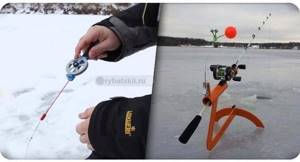
Passive gear is placed by the fisherman in promising places, and the bite on them occurs without the participation of the fisherman. The bite is reported by special indicators that can be seen from afar.
I recommend having a separate winter trout fishing rod for each type of tackle. Fishing rods for winter fishing are not expensive, and do not take up much space, and wasting time on re-equipment often carries the risk of missing a fish bite.
Spoons and rattlins
I spoke in detail about fishing with spoons in a separate article. With a trolling rod you can not only fish with lures, but also use some other lures. Rattlins, or as they are also called, “vibes” because of the peculiarities of their game (from the English Vibration - vibration).
Silicone (“rubber”)
Equip the second fishing rod for catching trout in winter with silicone baits, or as fishermen say, “with rubber.” The fishing rod has the same design, but is equipped with a guard to control the bait. Bites on silicone baits are often delicate, and playing with the bait requires less active play, which is why it is equipped with a guard. To deliver silicone bait to depth, “jig heads” of various modifications weighing 1–5 grams are used. For winter trout fishing, they must be equipped with a good, sharp and durable hook.

If thick winter fishing lines are acceptable for trolling - 0.25-0.3 mm, then for fishing with silicone a thinner line is needed, 0.23-0.25 mm. A small jig head on such a line looks more natural, this has a beneficial effect on the fishing result. The line supply on the reel for fishing in ponds is enough for 10–15 meters.
Trout fly fishing gear
Fly fishing is considered the domain of experienced fishermen, although the difference with spinning fishing is only in the essence of casting. In the case of spinning, a heavy bait is thrown and it dives to a certain point. Fly fishing works on the principle of heavy line with light bait. Before we throw the cord, they “play out” for the flight range.
Rod
- Select the length in the same way as for spinning.
- For river fish, when there is an abundance of thickets, a rod of shorter length (1.7, 1.9-2 meters) is preferable; for lake fish, there is a higher chance of ending up in non-vegetated areas, so you can take a rod up to 3 meters.
- The longer the chosen rod, the more successful the fishing will be.
- This is if we talk about coastal fishing. From a boat, always choose a short rod.
Selected fly fishing class
- Fly fishing gear is divided into weight classes from 0 to 15, where 0 is the ultra-light option, and 15 is the heaviest.
- For the chosen type of fishing, grades 3-8 will be optimal.
- The most convenient is considered to be the middle - 5th grade.
Fly fishing line
The thickness and weight of the cord also depends on the class of the fishing rod. As a rule, they are designated by the same class. Thus, when choosing a 3rd class rod, you will also need a 3rd class cord.
Leash
- The length of the leash is directly proportional to the length of the rod.
- If the specified rod is 2.7 meters long, then use a similar leash.
- The leash implies division into several equal parts, each of which becomes narrower towards the bait.
- The bait should have the thinnest leash. The difference can be up to 0.2 mm (0.35 mm on one side and 0.18 mm on the other).
- It is important to tie all parts correctly with strong knots.
Passive gear
Passive gear popular among fishermen is a trout “post” and a trout girder.
The trout fishing rod is made from a winter fishing rod with a nod, equipped with a 0.25-0.3 mm fishing line, a nod with a bright red ball at the end, and a pellet weight weighing 0.5-2 grams. The tackle ends with a hook 2–6 according to the Owner classification. Depending on the bait, it is used either natural (shrimp, squid strips, caviar, topsink) or artificial (usually trout paste, different colors and flavors, but from the same manufacturer Berkley).
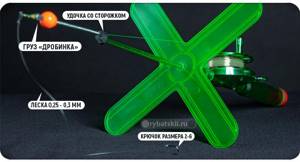
An important element of a trout setup is a crossbar, no less than 5 centimeters long longer than the diameter of the hole. The crossbar will not allow the fish to drag the fishing rod into the hole, while ensuring that the fish that bites will self-hook. A fishing rod turned over in a hole is visible from afar and informs the fisherman that a fish has bitten.
Use several such fishing rods, placing them in promising places in the reservoir, to determine the location of trout. Their number is limited by the rules of the reservoir. 2-3 fishing rods are enough, as well as a couple of spare fishing rods in case of damage or broken fishing line.
Also check out the ratings of ice fishing boxes and find out how to choose a quality model.
Features of feeder equipment for fishing trout on paid platforms
Fishing for trout using a feeder is fundamentally different from classical methods. When planning to prepare trout gear for feeder fishing, you should take into account that the fish feast on food in the middle layers of water. In this regard, it is important to ensure a fixed position of the bait at a certain level and not allow it to lie on the muddy bottom of the reservoir. To solve this problem, feeder gear for trout fishing is equipped with a special feeder that attracts large schools of fish at a given depth.
Read more
What is a drop shot rig for pike perch?
It is important to ensure the convenience and elegance of the feeder, since real fishing takes place at a distance of up to 25 m from the shore line. Feeder equipment for trout fishing includes:
- a rod whose length reaches 3.5 m;
- silent, inertia-free coil;
- nylon monofilament with a diameter of 0.2 mm;
- feeder to attract fish.
It is advisable to have several feeders, which are selected on site depending on the speed of the current and the depth of the reservoir. The parts of the feeder equipment are connected using a Gardner loop. It’s easy to get acquainted with its device on fishing websites.
It is important to observe the lengths of the loops and leash:
- the loop intended for the feeder should be 14-16 cm long. As the length increases, the magnitude of the vibrations of the bait that attracts prey increases;
- the second loop, which is also called a tap, is made in such a way that it is 4-5 cm larger than the size of the feeding loop;
- The leash for a good bite has a length increased to 1 m and is made of fishing line with a thickness of 0.12-0.14 mm. To ensure the bait floats up, the leash is attached using a loop without the use of a heavy carabiner.
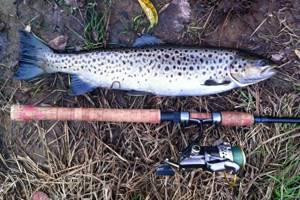
Fishing for trout using a feeder is fundamentally different from classical methods.
To summarize, it should be noted that the feeder is designed for remote fishing in the depths of a reservoir. Unlike the donkey, it is equipped with a feeder with complementary foods. The fish, attracted by the aroma of the bait, discover the bait. Many trout fishing enthusiasts have become convinced of the catchability of such gear.
Natural baits for trout fishing in winter
Let's look at the natural baits that most often catch trout in winter.
Shrimp
The basic, simplest and most accessible attachment is a small shrimp from the store, previously defrosted. The head comes off the shrimp, which we throw into the same hole to attract fish.
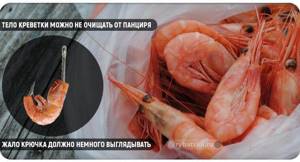
You don’t have to remove the shell from the body of the shrimp, but leave some elements to attract fish, for example, legs. The shrimp is attached to the trout like a worm, along the hook, with the sting brought out. Shrimp is a sinking bait, and when installing a fishing rod, it should not lie on the bottom, but should be in the water column at a distance of 10 cm to half the depth of the reservoir ( depending on the depth of fish activity ).
Trout paste
Trout paste is popular as bait. Fishermen use paste produced by Berkley, which has specialized in the production of products for trout fishing since 1945. The paste has different flavors and comes in different colors. The most popular are cheese and garlic. Roll a small ball from the paste and stick it around the hook of a trout hook or jig. Keep in mind that the paste used is floating, and the hook with the paste will float and be above the level of the sinker.
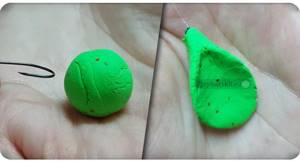
Verkhovka
No less catchy bait is a small live fish: verkhovka, or top-melting fish. Verkhovka is caught independently, using a lift in non-freezing areas of ponds, or sold in fishing stores, and requires careful storage. Often the verkhovka is sold directly on the reservoir.
The tip is placed either behind both lips, piercing them with a hook, or under the dorsal fin, but without damaging the spine. Often the verkhovna is the only bait that causes trout to bite in a pond, especially if the fish were introduced into the reservoir a long time ago and managed to switch to feeding on the existing verkhovka in the pond.
Squid strip
A strip of squid, which is cut from a thawed squid carcass, also shows good results. The strip should decrease towards the end, its thickness at the hook is up to 5 mm, and towards the end of the strip, about 5–10 cm long, the thickness decreases to a minimum. This bait looks good in the water column and moves with any movement of the water, provoking the fish to bite.
Red caviar
Large salted caviar from the store, such as chum or chinook caviar, is one of the best natural baits for passive fish when no other bait works. 10 grams of caviar is enough for one fishing trip.
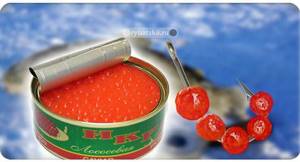
Place 4-5 eggs on the hook of the bait, and carefully watch the guard of the fishing rod. Sometimes move the nozzle, barely playing with a nod. When biting, the nod begins to bend slightly. Unlike other natural baits, trout rarely swallow eggs, so such a fishing rod requires constant monitoring and timely hooking. Caviar fishing is a transitional type of fishing, from passive to active. When fishing for caviar, choose a fishing rod with a thin line.
Caviar ovaries
There are also exotic, but no less catchy baits for supply, for example, frozen oysters cut into cubes of about 1x1 cm with fresh red caviar. You can use eggs with pink salmon caviar, which are often found in the store along with the purchase of uncut fish, but more often fishermen use frozen caviar of the trout itself from previous catches, preparing underdeveloped caviar for bait, which is of little use for consumption.
Choosing a trout spinning rod
Spinning rods for trout differ in their technical characteristics depending on the type of reservoir in which fishing is carried out. The natural conditions of a reservoir with rapid currents require more stringent conditions for the parameters of gear, in contrast to comfortable fishing on paid ponds with stagnant water. Let's consider the main approaches to choosing gear based on these differences in the structure of the reservoir.
Length selection
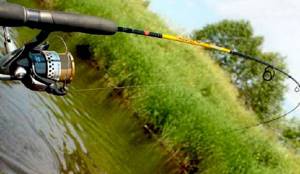
In a pay zone, the length of the gear is selected taking into account the possibilities of fishing from the shore or fishing from a boat. If casts are made from clean banks or a bridge, then a length of three meters is quite enough for easy fishing. From a boat, use gear no longer than 2.1–2.5 meters. Such tools allow casting with a more accurate supply of bait and not restricting the already limited space of the craft. On fast-moving streams, they fish in a wade, getting closer to promising fish sites, therefore, they use shorter tackle, ranging from 1.8-2.3 meters.
Important! Plug-in versions of fishing rods are preferable to telescopic ones, due to greater tactile sensitivity and reliability of the structure.
Scale selection
Slow and soft gear is used on pay fishing grounds, since the absence of currents gives a clear vision of the bite, and the slow action helps to catch fish efficiently on thin lines, without fear of their breaking. In conditions of strong currents, streaming versions of spinning rods with a rigid, ultra-fast action are used. This quality allows even with the slightest touch of the fish to the bait to detect it.
Test selection
Due to the use of light baits, they are caught using ultra-light versions of gear with tests no higher than 5 grams. In particularly strong currents, it is wise to use light spinning rods with weights up to 15 grams, which allows you to better deal with current resistance using weighted baits.
Coil selection
An important criterion for the reel is its light weight and the presence of a finely adjustable clutch. The elegance of the tackle depends on the balance of the rod and reel in their masses.
Important! The reel should have a high gear ratio; this is an important parameter when performing fast retrieving with the least amount of activity from the angler, which, even in minimal quantities, definitely alerts the fish.
Line selection
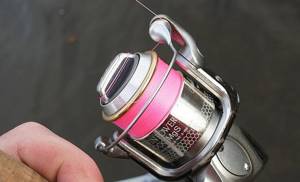
As the main cord, it is rational to use thin braided fishing lines in the color of water. But it is better to use monofilament or fluorocarbon as a driving material at the mounting tip. A meter cut is enough for quality fishing. The transparency of the line increases the fish's ability to attack, and the stretchability of the material perfectly compensates for overloads when fighting to catch a caught trophy.
Lures for fishing with silicone
Winter trout fishing with silicone baits is also popular. Let's consider working options.
Edible trout rubber
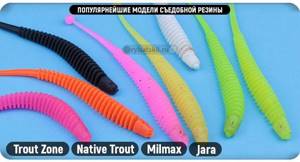
Edible trout rubber appeared in the arsenal of anglers only a few years ago, but has already become popular among anglers due to its catchability. It shows excellent results in fishing competitions, and has recently become very popular among anglers fishing for trout from ice.
Its main difference from conventional baits is the often aggressive, provoking colors, as well as the pungent smell and taste of flavorings, which have a magical effect on the fish. The small size of the rubber is convenient for attaching it to a single hook or to the hook of a jig head.
Such rubber is best stored and sold in jars with a tightly screwed lid. Due to the pungent smell, it is better not to open these jars at home, as you risk incurring the wrath of your relatives.
There are many varieties and manufacturers, for different fish, with different smells. The most popular flavors for ice fishing for trout are cheese and garlic.
Popular manufacturers – Trout Zone, Native Trout, Jara, Milmax, STL and others.
Ordinary silicone
Nymphs and vibrotails, various imitations of worms and larvae, silicone imitation of eggs - these are the main artificial baits for trout fishing.
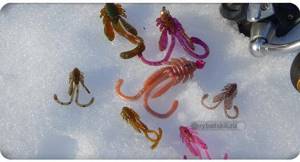
If edible rubber attracts fish primarily by smell and taste, then ordinary silicone attracts fish with its game, or rather, the game that the fisherman gives to the bait. Often a nymph becomes a fisherman’s lifesaver when the trout bite is capricious. The flagship among manufacturers is the mentioned Berkley company.
Putting pasta on a hook
Using trout paste is quite simple and convenient. After a few trainings, setting the bait will take no more than a minute, and your skills will improve. The entire process of stringing pasta onto a hook can be divided into several stages:
- First you need to pinch off a small piece of the mixture, roll it out on your palm and form a small ball in the shape of a pea.
- Next, you need to immerse the hook in the paste so that it is not noticeable. If any part of the hook remains uncovered, the fish may get scared. You need to attach the bait firmly so that it does not disintegrate in the water.
- After this, you need to give the bait a round or oval shape.
In the store you can buy a special paste mold that can turn an ordinary pea into a fry, mussel, larva or bug. This bait will look more believable and realistic, which will help attract the attention of trout.
Choosing an ice drill
To fish for trout, use an ice screw with a diameter of at least 150 mm. It will be problematic to get large and active trout into a narrower hole. Domestic ice drills, such as “Nero”, “Barnaul”, and imported Mora, Rapala are suitable. Imported ice drills require slightly less effort when drilling, and are also suitable for girls, who, fortunately, are increasingly seen on trout fishing. Domestic ice screws are a little more difficult to operate, but have cheap “consumables” - replaceable knives.
How to choose a fishing spot
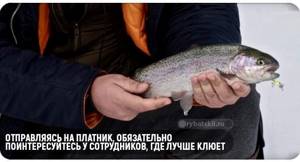
Places are chosen based on many factors. For a novice fisherman, it is better to choose proven places where they have recently caught fish. Ask the administrator of the reservoir about this, from whom you buy the ticket. As a rule, the employees are interested in you becoming a regular visitor to the pond, and will be happy to tell you about places where you are likely to catch trout.
Places where people actively fished yesterday are usually heavily trampled, and traces of fishing and blood are visible near the holes. Surely, if you drill a hole near such a place, there is a chance that trout will bite here today. It is possible that the hole has not yet frozen over night, and you can fish in the old hole. It is not customary to occupy any holes in advance when trout fishing.
There are also favorite trout habitats. To live, in order to obtain oxygen, the fish constantly moves, passing water through the gills. The second option is to strive for a source of additional oxygen in the pond - these are working aerators that create underwater currents. Winter trout often linger near the aerator and are well caught. Also, moving along the perimeter of the reservoir, trout likes to linger in the corners - this is also one of the most promising fishing spots. Having drilled 2-3 holes from the shore, measure the depth; usually trout, like other fish, moves along the coastal “edge”.
Fishing depth
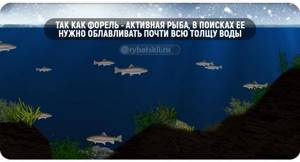
Trout is an active fish that explores all fishing horizons in search of food. It can be actively caught near the bottom, and after an hour it can move higher, right up to the ice edge. An important task for the angler after choosing a place is to determine the horizon where trout are active. To do this, after several swings of the bait, raise it a little higher, up to half the depth of the reservoir. If this does not bring results, try playing the bait 10–20 centimeters below the ice edge, gradually lowering the bait into the depths.
How to catch trout in winter using active baits
Let's take a closer look at fishing with rattlins (“Vibes”). Like spinners, these baits involve catching active fish, that is, in the morning and evening hours. Fishing with rattlins also consists of periodically tossing the bait with a fishing rod and long (2-10 seconds) pauses. When the bait is lifted upward, vibration from the unique play of the bait, which gives it its name, is transmitted to the angler’s hand. Do the toss either quickly, with a small jerk of 10–20 centimeters, or more smoothly.
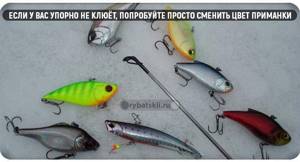
It is important to try to select the fishing technique that interests the fish. If there are no bites in the hole, you should rattle to another. Often the result is achieved simply by changing the color of the bait to another.
It is worth raising the bait higher, at half-water, and playing it high for a while, and then sharply dropping it half a meter down.
Bait supply
Unlike conventional feeder fishing, when fishing for trout you need to try to make sure that the hook with the bait does not sink or lands very slowly on the bottom. To achieve this effect, you can add some kind of buoyant material to the nozzle, for example, a piece of foam. The leash itself is best made from nylon coated with fluorocab. Such a fishing line will become as invisible as possible to the fish, while having sufficient elasticity.
We recommend reading: Catching rotan on the last ice
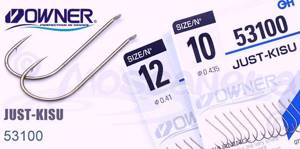
It is better to use light-weight trout hooks with a long shank. Size according to Owner classification 10 or 12. The elongated shape of the hook is needed for better detection of fish that bite at mid-water. In addition, the design of such a hook allows you to easily place an element of floating material.
The best live bait for trout fishing is a bunch of bloodworms or maggots. On some days, a sandwich made from these larvae works better, especially when bloodworms predominate.
Fish can bite in different layers of water, so it’s better to start with a short leash, 30 cm long. If the fish likes the bait, the bites will most likely begin at the bottom. It often happens that trout are interested in bait, but swim higher, picking up sinking particles. In such cases, you will have to experiment with the leash, gradually increasing its length. When experimenting with the length of the leash, it makes sense to recast after 5-10 minutes. You need to increase the length of the leash gradually, 10-20 centimeters at a time, changing the color of the foam ball.
The trout bite greatly depends on both the size and color of the bait. The best colors for light hook bait are yellow, red and green. It is advisable to have maggots of different colors with you.
At the beginning of feeder fishing, it is important that the trout make their presence known. When you manage to see the first bite, it becomes much easier, you can call it half the victory.
Although trout is a predatory salmon fish, fishing for it with a feeder often outperforms spinning rods in terms of effectiveness. Most likely, the point here is that the fish really responds well to bait.
Silicone fishing technique
The technique for catching trout with silicone baits is similar to catching peaceful fish with a jig in the water column. Having touched the jig head with the bait to the bottom, slightly raise the bait higher and shake it slightly. Raise it a little higher and swing it again, or hold a pause. Thus, we fish half the depth of the reservoir. If there are no bites in the holes, change the color and shape of the bait. Usually, passive fish are caught with silicone, which is difficult to get to bite on other baits. If everyone in the pond has stopped catching fish, then fishing with silicone can bring success. You can simply put the fishing rod on the ice and watch the guard; a passive fish may not be able to stand it and bite after a long pause.
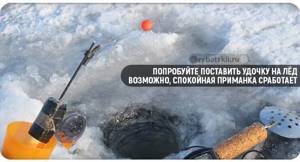
When biting, if the fish carefully touches the bait, wait before hooking. The signal to it will be a downward nod movement, this will mean that the fish has completely taken the bait into its mouth. Sometimes, with passive biting, more than a dozen seconds pass between the start of the bite and the hook.
Often the trout misses when attacking, if there is a single bite, pay more attention to this hole, usually you can catch this fish.
Some tactics will surely bring success. We must not forget that if today we picked up the bait and game, this does not mean that tomorrow the fish will be caught just as well with this bait. Trout fishing is unpredictable, which is why it attracts such a large number of anglers.
Float gear for trout fishing on platoons - the secrets of successful fishing
Trout fishing with a float attracts followers of fly fishing. The predator has a lightning-fast reaction and tries not to miss the passing food. Thanks to this feature, they hunt for trout in areas of rifts, near whirlpools, and also in places with oppositely directed currents. Float tackle is also used for pond trout. A dung worm and a special paste are used as bait.
Read more
How to choose bait for bream?
The float equipment includes:
- lightweight trout fishing rod up to 4 m long;
- standard coil with increased differential;
- trout fishing line wound on the reel spool;
- fluorocarbon leader for trout;
- weight and float, selected taking into account the specifics of fishing.
Trout gear intended for float fishing is also equipped with a hook No. 8-10. It is important to choose the right size and weight of the float so that it is visually perceived at a long distance and allows you to quickly respond to a bite from a predator. This is one of the secrets of a successful hunt.
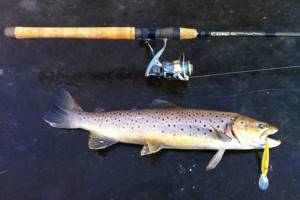
Fishing enthusiasts are attracted to fishing for trout using a float
Fishing technique with passive baits
Passive baits are placed on an unfamiliar body of water in potentially attractive places to determine the location of fish. If there are no bites at the chosen place for a long time, move the bait to another place, or change the fishing depth and nozzle.

If the fish is slightly interested in the bait, the nod on the rod twitches a little, but no bite occurs, or the fish quickly spits out the bait. First of all, change the nozzle to a fresh one. If this does not help, look, sometimes the nozzle is too large, and you should reduce it a little. Try moving the fishing rod to another place, and try fishing in this hole with a silicone bait, or using a spinner.
A fish that has bitten should not be pulled out of the hole by force; before the hole, the trout begins to frantically shake its head, and if at this moment you apply too much force, you can tear even the thickest fishing line with expensive bait, or break the hook.
The caught trout should be carefully brought to the hole and pulled out onto the ice when its movements subside a little. It will be good to pick up the fish in the hole with your hand without loading the fishing line. If the catch is so large that you cannot get its head into the hole, use a hook to hook the fish, or ask other fishermen to help. Perhaps an experienced neighbor can find a hook.
So, you have decided to buy a spinning reel for trout fishing.
As a rule, models developed for this type of fishing are not cheap. The following series are most in demand among athletes:
- Daiwa: Exist, Luvias, EM MS, Gekkabijin;
- Shimano: Vanquish, Soare.
Their price is not explained by the brand, but primarily by the functionality and characteristics that the reel has. This includes weight, smoothness, delicate work with expensive thin cords, strength and excellent line winding, ensuring the absence of beards and long casting. These advantages are not a complete list of the advantages of expensive ultralight reels.
However, if you are a novice angler, then you can easily find a budget, but quite high-quality model. Among budget reels, models such as Shimano Catana, Ryobi Ecusima , Daiwa Crest, Stinger Innova Ultralight and others have proven themselves well.
Possible beginner mistakes
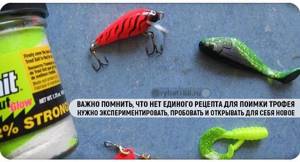
A common mistake that can explain poor catches or lack thereof is constantly catching trout with the same bait and in the same hole. After catching one fish, if there are no bites, try another tackle or bait. If the fish stops biting at the selected depth, you should periodically search at other depths. It is important to try to master fishing with both active and passive gear, and alternate between them, since the behavior of the fish on each fishing trip is different, and no one, even a titled athlete, can say for sure which bait will bring success the next day.
Trout fishing is not only about finding bait and location, but also about constantly watching other anglers. Learn to imagine the fish's routes and offer the trout a tempting bait along the way before the fish swims away or is caught by a neighbor.
Spinning tackle for trout - choosing the right equipment
Content
Trout fishing with a spinning rod is popular among beginners and experienced anglers. This kind of fishing is an interesting and exciting activity. With the help of a spinning rod it is very convenient to make long and accurate casts, as well as to fish out resisting prey. Properly selected spinning rod equipment for trout will allow you to catch a strong and cautious predator. Let's figure out what the tackle for trout fishing with a spinning rod consists of.

Among beginner fishing enthusiasts, trout fishing with a spinning rod is popular.
The main components of spinning equipment:
- rod It is characterized by length, dough and action. Fishing conditions determine the length of the whip, which ranges from one and a half to three meters. They fish with short and light rods from a boat or while in coastal thickets. The extended form is convenient on a clean bank. For successful fishing, a whip with a dough weight of up to 12 grams, with a fast or medium action, is suitable. Ultralight spinning tackle for trout for fishing with wobblers shows good results. Sections of such a fishing rod are made of carbon fiber, which has increased plasticity and responds to sharp jerks of strong fish when pulling it towards the shoreline or boat;
- fishing line and leash. Using a fishing line and a leash with a cross-section of 0.15-0.2 mm, a spinning rod absorbs force at the moment of biting, as well as when landing fish. For trout hunting, we choose a monofilament type fishing line. The length of the leash is also important. Experienced spinning anglers use a leash with a length of 50 to 70 cm. The leash for trout on a spinning rod is made of nylon and is hardly noticeable in clear water. Mono-profile trout fishing line is resilient, elastic and does not spring back. And although braided cord is often used for spinning equipment, it is difficult for it to compete with nylon thread in terms of characteristics. Trout braid is used for long casts over a length of more than 30 meters;
- coil. Depending on the design of the spool and the diameter of the monofilament, up to one hundred meters of fishing line can be placed on the reel. To catch trout, the reel must be equipped with a spinning mechanism and have a gear ratio of 5-5.5. The increased differential allows you to quickly reel in your prey. It is important to adjust the brake clutch to the expected weight of the fish. The brake dampens the jerks of the caught trout. When choosing a reel, pay attention to quiet operation, quality of line laying and the inability to twist the thread when casting. A friction mechanism with good sensors will allow the fisherman to quickly respond to a bite.
Read more
What to use to catch grass carp?
Having selected spinning equipment, you should master the technique of retrieving, depending on the type of bait and fishing location. Jerky wiring is suitable when using wobblers, but for spinners, a uniform pull should be performed. Depending on the conditions of spinning fishing, natural baits or artificial baits are used, which are difficult for a predator to distinguish from natural ones.
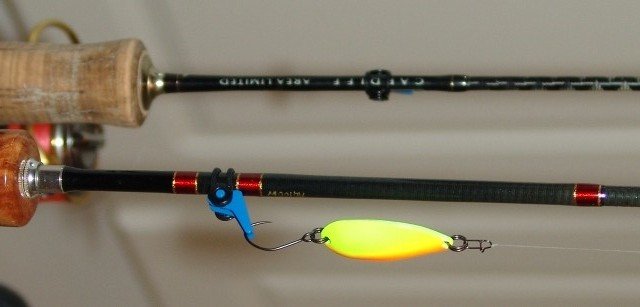
Natural baits or artificial baits are used depending on the spinning fishing conditions
